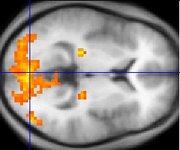Statistical parametric mapping
|
|
Statistical parametric mapping or SPM is a statistical technique for examining differences in brain activity recorded during functional neuroimaging experiments using brain imaging technologies such as fMRI or PET. It may also refer to a specific piece of software created by the Wellcome Department of Imaging Neuroscience (part of University College London) to carry-out such analyses.
| Contents |
The statistical parametric mapping approach
Unit of measurement
Functional neuroimaging, one type of 'brain scanning', involves the measurement of brain activity. The technique used to measure brain activity varies depending on the technology being used (see fMRI and PET for examples) although regardless of the particular method used, the scanner will produce a 'map' of the area being scanned, represented as voxels. Each voxel typically represents the activity of a particular co-ordinate in three dimensional space. The exact size of a voxel will vary depending on the technology used, although fMRI voxels typically represent a volume of 3mm3.
Experimental design
Researchers are often interested in examining brain activity linked to a specific psychological process or processes. An experimental approach to this problem might involve asking the question 'which areas of the brain are significantly more active when a person is doing task A compared to task B ?'. Although each task might be designed to be identical, except for the aspect of behaviour under investigation, the brain is still likely to show changes in activity between tasks due to factors other than task differences (as the brain is involved with co-ordinating a whole range of parallel functions unrelated to the experimental task). Furthermore, the signal may contain noise from the imaging process itself.
To accommodate these random effects and to highlight the areas of activity linked specifically to the process under investigation, statistics are used to look for the most significant difference above and beyond background brain activity.
This involves a multi-stage process to prepare the data, and to subsequently analyse it using a statistical method known as the general linear model.
Image pre-processing
Images from the brain scanner may be pre-processed before any statistical comparison takes place to remove noise or correct for sampling errors.
MRI_ImageSmoothing.png
A study will usually scan a subject several times. To account for the motion of the head of the subject between the scans the images will usually be adjusted so each voxels in the images corresponds (approximately) to the same site in the brain. This step is referred to as realignment or motion correction, see image realignment.
Functional neuroimaging studies usually involve a number of participants, all of which will have slightly differently shaped brains. All are likely to have the same gross anatomy, although minor differences will be apparent due to differences in (for example) skull shape and size. To aid comparisons, the 3D image of each individual's brain is transformed so the structures 'line up', a process known as normalisation. Standard brain maps such as the Talairach-Tournoux or MNI template are often used to allow researchers from across the world to compare their results in a common format.
Images are often smoothed (similar to the 'blur' effect used in some image-editing software) by which voxels are averaged with their neighbours, typically using a Gaussian filter or by wavelet transformation, to make the data less noisy.
Statistical comparison
Parametric statistical models are assumed at each voxel, using the general linear model to describe the variability in the data in terms of experimental and confounding effects, and residual variability. Hypotheses expressed in terms of the model parameters are assessed at each voxel with univariate statistics.
Analyses may also be conducted to examine differences over a time series (i.e correlations between a task variable and brain activity in a certain area) using linear convolution models of how the measured signal is caused by underlying changes in neural activity.
Because many statistical tests are being conducted, adjustments have to be made to control for Type I errors potentially caused by the comparison of levels of activity at a large number of voxels. In this case, a Type I error would result in falsely detecting background brain activity as activity related to the task. Adjustments are made, based on the theory of continuous random fields and a new criteria for statistical significance is set to adjust for the problem of multiple comparisons.
Graphical representations
Differences in measured brain activity can be represented in a number of ways. Most simply, they can be presented as a table, displaying co-ordinates that have shown the most significant differences in activity between tasks. However, differences in brain activity are more commonly shown as patches of colour on an MRI brain 'slice', with the colours representing the location of voxels that have shown statistically significant differences between conditions. Differences in activity may also be represented as a 'glass brain', a representation of three outline views of the brain, as if it were made of glass and only the patches of activation visible as areas of shading.
|
Missing image Glassbrain.png Brain activation from fMRI shown in 'glass brain' format |
SPM software
SPM is software written by the Wellcome Department of Imaging Neuroscience at University College London to aid in the analysis of functional neuroimaging data. It is written using MATLAB and is distributed as free software.
See also
- brain imaging
- cognitive neuroscience
- functional magnetic resonance imaging
- functional neuroimaging
- general linear model
External links
- Wikibooks (http://en.wikibooks.org/wiki/SPM) SPM Wikibook.
- SPM (http://www.fil.ion.ucl.ac.uk/spm/) software and documentation from the Wellcome Department of Imaging Neuroscience.
- Cambridge Imagers (http://www.mrc-cbu.cam.ac.uk/Imaging/Common/) - Neuroimaging information and tutorials.
- SPM-Information to include in papers (http://en.wikibooks.org/wiki/SPM-Information_to_include_in_papers)

